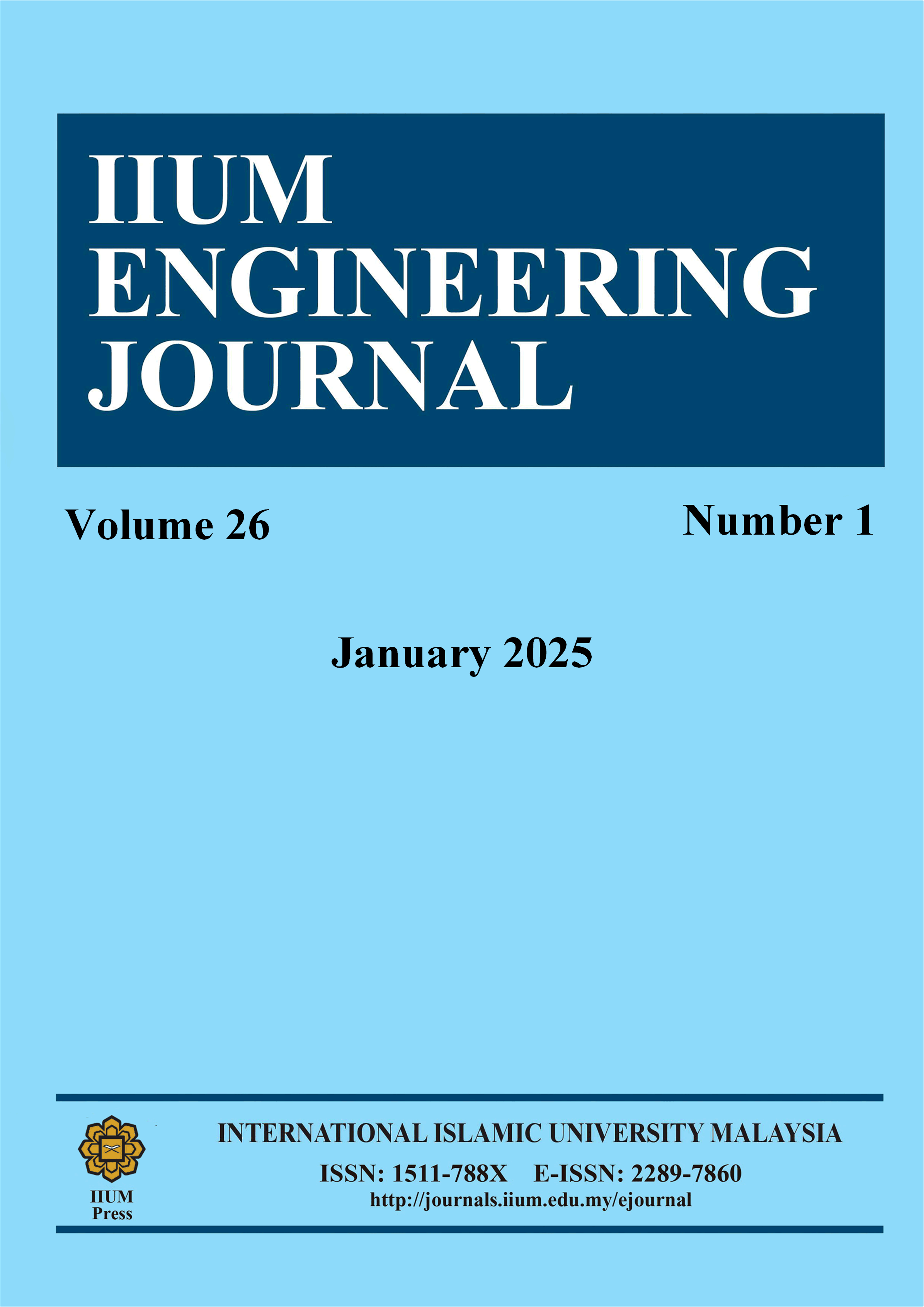Bentonite-Amended Geo-Polymerised Fly Ash-GGBS Mixture for Waste Containment Applications
DOI:
https://doi.org/10.31436/iiumej.v26i1.3244Keywords:
alkali treatment, bentonite, fly ash, GGBS, permeability, strengthAbstract
The reuse of Fly Ash (FA) with the optimum amount of Ground Granulated Blast Furnace Slag (GGBS) polymerized with an alkali solution for the construction of barriers for waste containment and vertical cutoff walls for the contaminated ground is explored in this study. For this, detailed strength and permeability tests have been conducted on different ratios of FA and GGBS compacted and cured for up to 28 days. Compacted samples of FA and GGBS mixtures, at an optimal ratio of 40:60, were polymerized with sodium hydroxide alkali solution up to 5 molar concentration, as the effectiveness of polymerization varies with alkali concentration. The significant increase in compressive strength is attributed to pozzolanic reactions, whereas the increase in tensile strength is due to the polymerization of the components of the mixtures. Geopolymerisation is done through the incorporation of alkali and is known to enhance pozzolanic activity by converting part of silica to reactive silica, producing more pozzolanic compounds and part modification of pozzolanic reaction compounds. To optimize the increase in compressive strength and the percent reduction in tensile strength, the maximum concentration of alkali is restricted to 5 M. To reduce the permeability for their application in the construction of the barrier, a 5% bentonite, in addition to the optimum FA-GGBS mixture, is considered, as its high specific surface and negative charges can retain ionic contaminants such as heavy metals. Both compressive and tensile strength increased over curing, and permeability decreased. The retention capacity of selected heavy metal (lead and nickel) ions is due to their precipitation in the voids of the barrier materials.
ABSTRAK: Penggunaan semula Abu Terbang (FA) dengan jumlah optimum Lebihan Pasir Kisar Relau Bagas (GGBS) yang dipolimerkan dengan larutan alkali bagi pembinaan penghalang pembendungan sisa dan dinding titik potong menegak bagi tanah tercemar diterokai dalam kajian ini. Bagi tujuan ini, ujian kekuatan dan kebolehtelapan terperinci telah dijalankan pada nisbah berbeza FA dan GGBS yang dipadatkan dan diawet selama 28 hari. Sampel padat campuran FA dan GGBS, pada nisbah optimum 40:60, digeopolimerkan dengan larutan alkali natrium hidroksida sehingga 5 kepekatan molar, kerana keberkesanan pempolimeran berbeza dengan kepekatan alkali. Peningkatan ketara dalam kekuatan mampatan adalah disebabkan oleh tindak balas pozzolanik, manakala peningkatan dalam kekuatan tegangan adalah disebabkan oleh pempolimeran komponen campuran. Geopolimerisasi adalah melalui penggabungan alkali dan diketahui dapat meningkatkan aktiviti pozzolanik melalui penukaran sebahagian silika kepada silika reaktif, menghasilkan lebih banyak sebatian pozzolanik dan sebahagian pengubahsuaian sebatian tindak balas pozzolanik. Bagi mengoptimumkan peningkatan kekuatan mampatan dan pengurangan peratus kekuatan tegangan, kepekatan maksimum alkali dihadkan kepada 5 M. Bagi mengurangkan kebolehtelapan penggunaannya dalam pembinaan halangan, bentonit 5% sebagai tambahan kepada campuran optimum FA-GGBS dipertimbangkan, kerana permukaan spesifiknya yang tinggi dan cas negatif boleh mengekalkan bahan cemar ionik seperti logam berat. Kedua-dua kekuatan mampatan dan tegangan meningkat berbanding pengawetan, dan kebolehtelapan berkurangan. Kapasiti pengekalan ion logam berat (plumbum dan nikel) terpilih adalah disebabkan oleh pemendakannya di dalam lompang bahan penghalang.
Downloads
Metrics
References
Raj K, Das A. P (2023). Lead pollution: Impact on environment and human health and approach for a sustainable solution. Environmental Chemistry and Ecotoxicology, 5, 79–85. doi: 10.1016/j.enceco.2023.02.001 DOI: https://doi.org/10.1016/j.enceco.2023.02.001
Phoo-Ngernkham T, Maegawa A, Mishima N, Hatanaka S, Chindaprasirt P (2015). Effects of sodium hydroxide and sodium silicate solutions on compressive and shear bond strengths of FA–GBFS geopolymer. Construction and Building Materials, 91, 1–8 doi: 10.1016/j.conbuildmat.2015.05.001 DOI: https://doi.org/10.1016/j.conbuildmat.2015.05.001
Deka A, Sreedeep S (2016). Contaminant retention characteristics of fly ash–bentonite mixes. Waste Management & Research, 35(1), 40–46. doi: 10.1177/0734242x16670002 DOI: https://doi.org/10.1177/0734242X16670002
Hui X, Wan Y, He X, Li J, Huang X, Liu L, Xue Q (2023). Using alkali-activated dredge sludge ash-bentonite for low permeability cutoff walls: The engineering properties and micromechanism. Environmental Technology and Innovation, 30, 103060. doi: 10.1016/j.eti.2023.103060 DOI: https://doi.org/10.1016/j.eti.2023.103060
Cristelo N, Glendinning S. G, Fernandes L, Pinto A. T (2012). Effect of calcium content on soil stabilisation with alkaline activation. Construction and Building Materials, 29, 167–174. doi: 10.1016/j.conbuildmat.2011.10.049 DOI: https://doi.org/10.1016/j.conbuildmat.2011.10.049
Bernabeu, J. P., Monzó, J., Borrachero, M. V., Soriano, L., Tashima, M. M. (2022a). Activadores alternativos para cementos de activación alcalina. Revista Alconpat, 12(1), 16–31. https://doi.org/10.21041/ra.v12i1.568 DOI: https://doi.org/10.21041/ra.v12i1.568
Gupt, C. B., Bordoloi, S., Sahoo, R. K., Sreedeep, S. (2021). Mechanical performance and micro-structure of bentonite-fly ash and bentonite-sand mixes for landfill liner application. Journal of Cleaner Production, 292, 126033. https://doi.org /10.1016/ j.jclepro. 2021.126033 DOI: https://doi.org/10.1016/j.jclepro.2021.126033
Amran, Y. M., Alyousef, R., Alabduljabbar, H., El-Zeadani, M. (2020). Clean production and properties of geopolymer concrete; A review. Journal of Cleaner Production, 251, 119679. https://doi.org/10.1016/j.jclepro.2019.119679 DOI: https://doi.org/10.1016/j.jclepro.2019.119679
Prashanth J, Sivapullaiah P. V, Sridharan A (2001). Pozzolanic fly ash as a hydraulic barrier in land fills. Engineering Geology, 60(1–4), 245–252. doi: 10.1016/s0013-7952(00)00105-8 DOI: https://doi.org/10.1016/S0013-7952(00)00105-8
Bagheri, A., Alibabaie, M., Babaie, M. (2008). Reduction in the permeability of plastic concrete for cut-off walls through utilization of silica fume. Construction and Building Materials, 22(6), 1247–1252. https://doi.org/10.1016/j.conbuildmat.2007.01.024 DOI: https://doi.org/10.1016/j.conbuildmat.2007.01.024
Azhar U, Ahmad H, Shafqat H, Babar M, Munir H. M. S, Sagir M, Arif M, Hassan A, Rachmadona N, Rajendran S, Mubashir M, Khoo K. S (2022). Remediation techniques for elimination of heavy metal pollutants from soil: A review. Environmental Research, 214, 113918. doi: 10.1016/j.envres.2022.113918 DOI: https://doi.org/10.1016/j.envres.2022.113918
Devarangadi M, M U. S (2019). Use of ground granulated blast furnace slag blended with bentonite and cement mixtures as a liner in a landfill to retain diesel oil contaminants. Journal of Environmental Chemical Engineering, 7(5), 103360. doi: 10.1016/j.jece.2019.103360 DOI: https://doi.org/10.1016/j.jece.2019.103360
Consoli N. C, Heineck K. S, Carraro J. A. H (2010). Portland Cement Stabilization of Soil–Bentonite for vertical cutoff walls against diesel oil contaminant. Geotechnical and Geological Engineering, 28(4), 361–371. doi: 10.1007/s10706-009-9297-5 DOI: https://doi.org/10.1007/s10706-009-9297-5
ASTM C 618, “Standard Specification for Coal Fly Ash and Raw or Calcined Natural Pozzolan for Use as a Mineral Admixture in Concrete,” ASTM International, West Conshohocken, Pa., 2001, 4 pp
Anuradha, R., Sreevidya, V., Venkatasubramani, R., Rangan, B. V. (2012). Modified Guidelines For Geopolymer Concrete Mix Design Using Indian Standard. Asian Journal Of Civil Engineering (Building And Housing), 13(3),357– 68.
Devarangadi M, M U. S. (2020). Correlation studies on geotechnical properties of various industrial byproducts generated from thermal power plants, iron and steel industries as liners in a landfill- a detailed review. Journal of Cleaner Production, 261, 121207. doi: 10.1016 /j.jclepro.2020.121207 DOI: https://doi.org/10.1016/j.jclepro.2020.121207
Fan, R.-D, Yang Y, Liu S (2021b). Impact of in situ soil in Soil-Bentonite cutoff wall backfill on compressibility and hydraulic conductivity. Advances in Civil Engineering, 2021, 1–12. doi: 10.1155/2021/9350604 DOI: https://doi.org/10.1155/2021/9350604
Su, J., Huang, Z., Ren, L. (2007). High compact melamine-formaldehyde microPCMs containing n-octadecane fabricated by a two-step coacervation method. Colloid & Polymer Science, 285(14), 1581–1591. https://doi.org/10.1007/s00396-007-1729-2 DOI: https://doi.org/10.1007/s00396-007-1729-2
Grace, M. A., Clifford, E., Healy, M. G. (2016). The potential for the use of waste products from a variety of sectors in water treatment processes. Journal of Cleaner Production, 137, 788–802. https://doi.org/10.1016/j.jclepro.2016.07.113 DOI: https://doi.org/10.1016/j.jclepro.2016.07.113
M, B., Sudhir, Chen, S., Rai, S., Jain, D. (2022). An empirical model for geopolymer reactions involving fly ash and GGBS. Advances in Materials Science and Engineering, 2022, 1–13. https://doi.org/10.1155/2022/8801294 DOI: https://doi.org/10.1155/2022/8801294
Downloads
Published
How to Cite
Issue
Section
License
Copyright (c) 2024 IIUM Press

This work is licensed under a Creative Commons Attribution-NonCommercial 4.0 International License.






















